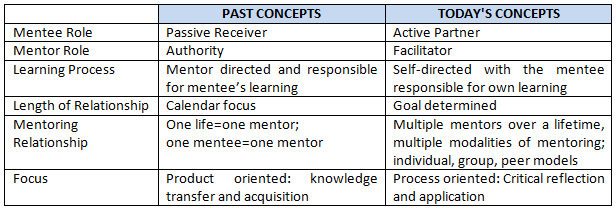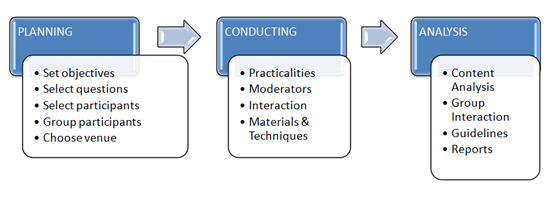Val Workman
The opinions expressed by the bloggers below and those providing comments are theirs alone, and do not necessarily reflect the opinions of Ryma Technology Solutions. As they say, you can't innovate without breaking a few eggs...
Focus Group - Mentors
I defiantly want to talk about Focus Groups, but in the context of mentoring. I want to avoid a potential misunderstanding about what I mean by "mentor" before we start, then I'll come back at the end of this posting to finish talking about the Focus Group Mentor.
The notion of mentoring is changed over the years, and I've included this table to highlight some of those changes. When I talk about mentoring, I'm referring to today's concepts of mentoring.

This method places our focus group as a mentor to the product management team. This mentor helps the product management team address a critical issue in listening to the voice of the customer. It offers a solution for the 2,500 year old innovation challenge: "How can we achieve a democracy of engaged citizens [customers & prospects], a democracy of face-to-face discussion, in states [markets] that contain many thousands or even many millions of people?". The answer is representation.
The focus group is a form of market representation. The focus group becomes a single representative or mentor for our product management team. This is especially true when we build our focus groups to represent one persona. So what is a focus group? A group of people with sufficient know-how, or a group of both customers and prospects engaged in relatively unstructured discussion on a selected topic related to a product or service. In this method, we add a little more structure to help the group become our mentor.
There are three main phases of using focus groups, there's the Planning phase, the Conducting phase, and the Analysis phase. In practice, each phase leverages a number of decisions that need to be made carefully to avoid jeopardizing the results produced by the focus group.

Most methods begin with setting the objects, and the focus group isn't any different. Focus groups can be used to accomplish many different types of objectives, today our interest in focus groups comes from our desire to have the market mentor us, so the objective will be similar to "understand users, tasks, and behaviors" or "identify problems and establish user and task needs". Your objectives need to be formally defined in order to select the right questions to be asked in the focus group.
I've found it useful to have 5-6 questions, in a 60- to 90-minute session, this should be enough to keep everyone engaged. I'll tell you, the easiest way to discipline a Focus Group is to keep them engaged so they don't have time to act up. Open-ended questions are preferred, because they stimulate broad discussion. Focus groups should be based on a pre-established but flexible structure. Plan some time for divergent and convergent thinking for each question.
When selecting and recruiting participants, care needs to be taken to recruit a representative sample of the targeted market. It's important to have participants with a certain level of knowledge and interest in your offering. Having initial participants nominate others also works. Guidelines on selection criteria should be formalized. The focus group should be between 6-10 people.
When multiple focus groups are planned, they should be grouped in order to be as homogenous as possible. The best grouping I've found for my uses are by targeted personas of each offering. Common groupings are based on education level, authority within the organization and gender. Typically, 2-3 groups are sufficient for most market sensing needs.
The focus group venue depends on many things, begging with the objective of the focus group. Normally, your company's office building is best, but geographic location can be a factor. Participants may prefer a local hotel. Sometimes a neutral meeting place is an important aspect of the focus group's objective. There is no single right answer, but overall, the venue should be relaxed and not interrupted.
During the Focus Group session, the proceeding should be recorded – trying to write everything down is impossible, selective listening and missing all the changes in tone lead to very biased transcripts. The general rule is that for a focus group session lasting about 30 minutes, an additional 10 should be used to create the appropriate atmosphere for effective discussion. At the end of the focus group meeting, it is important to reward the participants in some way.
The role of the moderator is vital, because the task of the group interviewer – frequently called the moderator or facilitator – is not to conduct interviews simultaneously but to facilitate a comprehensive exchange of views in which all participants are able to speak their minds and respond to the ideas of others. The moderator must be a good listener, a motivator, empathetic, nonjudgmental, and able to adapt to the situation.
One of the most challenging tasks of the moderator is to ensure sufficient group interaction and that everyone participates. The moderator establishes and maintains the ground rules for participation. Specific action must be taken to address participants who dominate the conversation as well as those who are too shy to contribute or tend to ramble on and on.
In order to support group interaction and discussion, the product management team can use a variety of materials. Normally examples of the product used are.
The analysis of the focus group research has to be careful and systematic. Content analysis is based on the transcripts, the moderator's, and other observer's notes. This is an analysis of the group, not individuals. Analysis also spans groups, and group comparisons are typical depending on the objectives. Another important part of analyzing focus group transcripts is to look for interesting quotes, metaphors, and stories.
In the analysis, it is important to note how people talked about a topic, the language they used, their tone of voice, and body language used. It is vital to report emotions, tensions, or conflicts within the group. This gives the product management team a deeper understanding of the aspects of a product that our customers can't easily discuss in public.
Typical reports include thematic, chronological, narrative, and ethnographic types.
With this method in place, the focus group can provide opportunities of discovery, exploration, and relationship-building within our communities. Refinement of skills with a view to effectiveness and efficiency can be achieved by applying lessons learned from our mentors. These mentors can provide opportunities of thoughtful reflection on our past experiences and product management activities.
In short, we need to build a relationship between our focus groups and product management teams based on a mutual discovery process in which both the mentor and mentee have something to bring to the relationship. Wisdom is not passed down but discovered and nurtured by all participants of the focus group.
We need to enable the market. Its ready to mentor us, the question is: are we ready to be mentored by the market?









Is this the wild photobook thing or the scandal where he was blackmailed by the girl he's with. Freezing and thawing instructions: If freezing, bake chicken for 20 minutes only.